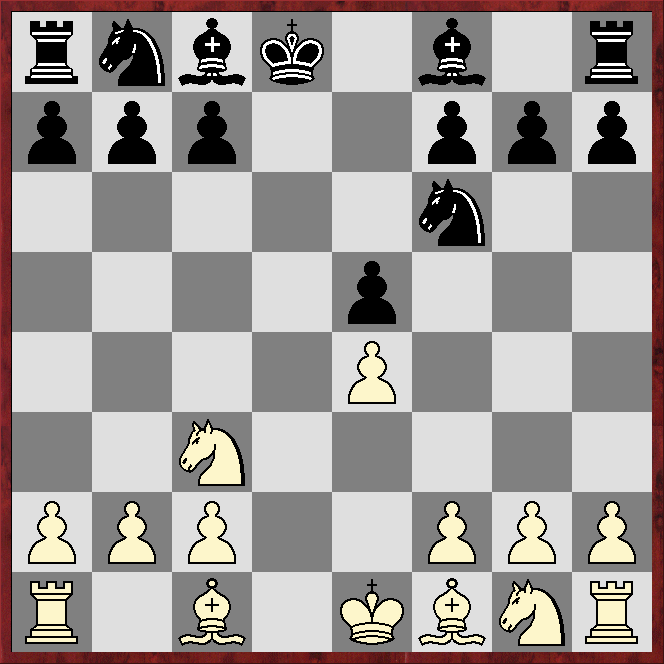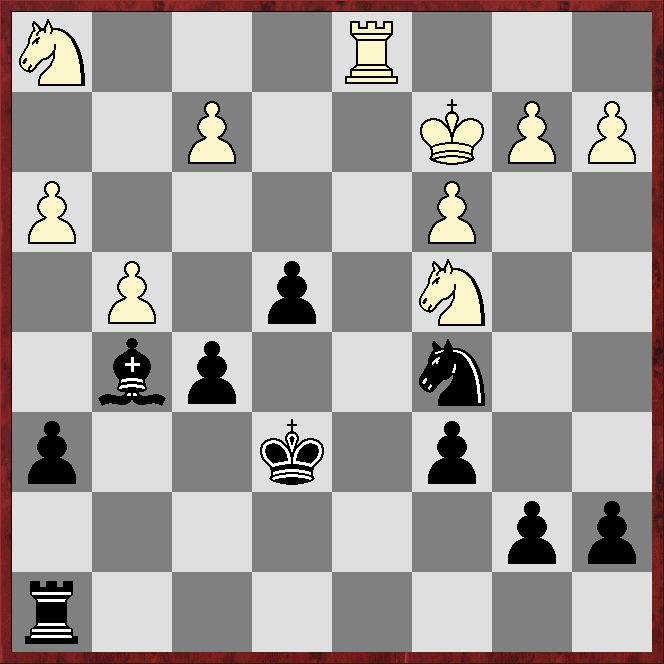This is sometimes also classified as a Pirc, but should, in my opinion, be regarded as a branch of the Philidor.
One interesting point is that strong engines, for example Stockfish15.1 and Komodo14.1, regard ...e5 as the best continuation, and I am sure this is one reason why the variation has become popular.
Not so long ago, the idea of allowing White to capture on e5 and then d8, denying Black castling rights, would have been more-or-less dismissed out of hand.
*****
*****
*****
*****
I have had the diagram position seven times with white.
Twice I captured on e5, but the other five times I developed the king's knight to f3.
My choice has not been irrational, at least if praxis is considered.
In ChessBase's 2023 Mega database, the knight development occurs 18,206 times, with White scoring 56%, while capturing on e5 occurs 8,477 times, with White scoring 45%.
The five times I played Nf3, I won twice (both against lower-rated opponents) and lost thrice (all against higher-rated opponents).
My average rating in those games was 1879, but my performance rating was 1780.
Both times I played dxe5 I drew (both opponents were higher-rated). My average rating was 1941, but my performance rating was 2150.
These are small sample sizes, but give food for thought.
The continuation 4.dxe5 dxe5 5.Qxd8+ is certainly logical, and after 5...Kxd8 White must have a slight edge.
*****
*****
*****
*****
My two games with 4.dxe5 illustrate the problems a higher-rated black faces in playing for a win.
Spanton (1908) - Peter Poobalasingam (2243)
Southend Easter 2016
1.d4 d6 2.e4 Nf6 3.Nc3 e5!? 4.dxe5 dxe5 5.Qxd8+ Kxd8 6.Nf3
Most popular is 6.Bg5, for which see the next game. Also more popular than the text is 6.Bc4, when the mainline in Mega23 runs 6...Be6!? 7.Bxe6 fxe6 8.f3 Bd6!? 9.Be3 Ke7, after which the engines reckon White is at least slightly better, but Black scores a respectable 47%.
6...Bd6 7.Bc4 Ke7
This probably keeps more play in the position than 7...Be6!?
8.Bg5 c6 9.h3 h6 10.Bh4 Be6 11.Bxe6 Kxe6 12.0-0-0
*****
*****
*****
*****
The engines agree any theoretical edge White has has withered away. But with queens off the board, and a more-or-less symmetrical pawn-structure without weaknesses, it is going to be hard for either side to make progress.
12...Bb4 13.Bxf6 Kxf6 14.Ne2 Ke6 15.Ng3 g6 16.Rd3 Na6 17.c3 Bcx5 18.Rd2 Rad8 19.Rhd1 Bb6 20.Rxd8 Bxd8!?
Presumably trying to keep some play in the position.
21.Kc2 Nc5 22.Nd2 Bh4 23.Nh1 f5 24.exf5+ gxf5 25.Nc4 e4 26.g3 Bg5 27.g4?!
The engines prefer 27.Rd6+ Ke7 28.Rd1.
*****
*****
*****
*****
27...e4?!
27...e4?!
Creating a 2-1 central majority, but leaving the position completely equal, according to the engines, which reckon 27...fxg4 28.hxg4 Rd8!? 29.Rxd8 Bxd8 30.Ng3 Kd5 31.Nd2 Bh4 32.Nf5 Bxf2 33.Nxh6 e3 gives Black at least the upper hand.
28.b4 Nd7 29.Nd6 Nf6?!
Defending the e pawn, but the engines reckon it is better to let it go, eg 29...Ne5 30.Nxe4 Be7, when the threat of ...h5 gives good compensation.
30.Nxb7 Nd5?
Black had to play 30...h5 or 30...Ke7, albeit conceding a slight edge, according to the engines.
31.Nc5+ Ke5 32.Nd7+?!
Strong, according to the engines, is 32.Rd4.
32...Ke6?!
Seemingly better is 32...Kd6.
33.Nc5+ Ke5 34.Nd7+?! Ke6?! ½–½
Spanton (1975) - Anthony Higgs (2058)
McArthur Cup Semi-Final (Hastings & St Leonards at Horsham) 20201.d4 Nf6 2.Nc3 d6 3.e4 e5!?
As can be seen, there are several ways to reach the starting position of the first diagram above.
4.dxe5 dxe5 5.Qxd8+ Kxd8 6.Bg5 Ke8?
The main move in Mega23 is 6...Be6, after which White scores just 41%, although the engines reckon 7.0-0-0+ Nd7 8.f4!? gives White a slight edge.
7.Bxf6 gxf6 8.Nd5 Bd6 9.Nxf6+ Kf8





Typo in line 1 ... Black can't play ... d6 twice!
ReplyDeleteCorrected - thanks!
ReplyDelete